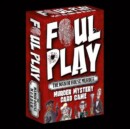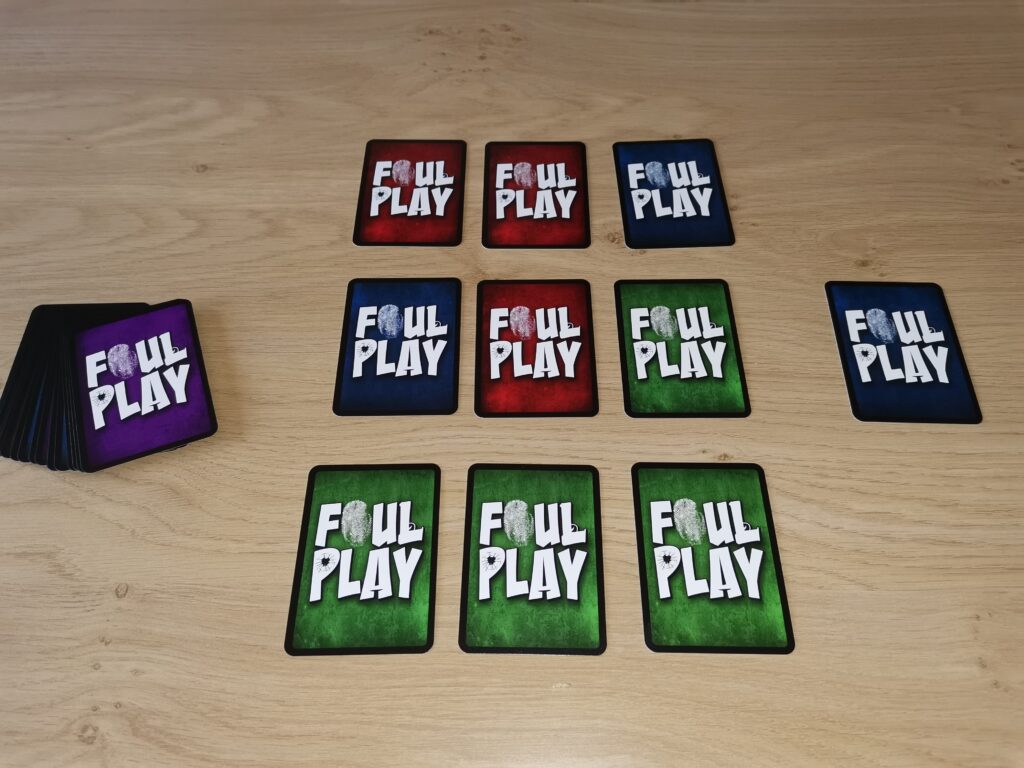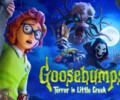
Players: 2-5
Age: 14+
Duration: +- 5-20 minutes
Distributor: Little Gargoyle Ltd.
Foul Play – Card Game Review
The classic board game Clue(do) is still a staple in many households. The game has made its appearance on many different board game evenings since 1949. Nonetheless, even though this timeless classic may still entice many board game enthusiasts to whip out their detective skills, not everyone has the time to spend several hours deducting who might have killed who in a paper-crafted universe. This brings us to other companies, such as Little Gargoyle Ltd., who want to translate the atmosphere of Clue into a pocket-sized and easy-to-play experience. We dug right into the card game of Foul Play, which mimics the concept of a murder mystery game, with its own original twists.
Contents
- 52 game cards
- 4 instruction cards
The deck of cards consists of several different components. Some card will have simple instructions on them, with a matching symbol, while other tell you more about the evidence. Last but not least there are the character cards, which are all nicely designed with comic-book-like characters. Outside of the cards you play the game with, there are the four instruction cards. These are not really the game’s rules, but more serve as a reminder of how things work. For the full rules, it’s best to go to the official site and view the tutorial video. The tutorial video does forget to mention one component, namely how the nine cards in the middle work. When playing the game, this will become clear, as you’ll have cards to swap these and view what is on them via the action cards.
We do advise also printing out the suspect sheet for your plays, as well as perhaps keep a small notepad (per player) nearby. While the latter may make it clear you have found pieces of evidence, you could also spice up the gameplay and use this as a bluff.
Mechanics
The offset of the game is actually quite simple in both different variants. It’s up to you to either find the murderer by collecting evidence or you either frame someone by doing almost the same thing. In the Good Cop variant, you will have to come across all evidence cards and then make an assessment on who the culprit is. For this, you’ll have to have the suspect card in your possession. For the Bad Cop version, you’ll have to have three different pieces of evidence in your hands (A, B, and C) and a possible candidate for your framing attempt that aligns with your evidence. The first version only has three pieces of evidence shuffled throughout the deck, while the second one uses all fifteen evidence cards. Overall the game is very simple, as all cards clearly indicate what action has to happen.
In Foul Play, it’s a constant shift of what cards you have in your hands, as most cards either allow you to swap a card with one of the nine cards in the middle or with a fellow player. Another card allows you to steal one card from another player, making it so you have an extra card each turn, and your victim will have to play with one less card each turn (until she/he returns the favor). The same number of cards have to be in play at all times, thus meaning if two players start out with five cards each, ten cards in total are in their hands. In case of stealing a card, one player will continue onwards with six cards, while the other one keeps four cards.
When playing a few matches, it will become clear that many suspects or culprits have many similar features, making sure there are different possibilities as ‘whodunnit’. You may for example find a piece of evidence that states the killer wears glasses, and then you’ll see that several characters wear glasses. This also contains more obscure items such as ‘wearing a red flower’, which could mean one pinned to a hat, or even a tattoo. This makes it so that everyone might find a possible culprit, rather than leave it up to one lucky player.
Luck or Strategy?
While a bit of strategy is key in certain situations, the game is very much luck-based. It all depends on what cards players steal from you and the cards you draw. In certain scenarios, it’s possible that you never come across any evidence cards, while the other player(s) have collected (or viewed) them all in a handful of turns. This is not a bad thing per se, but those looking to actually plan ahead may be a bit disappointed. The random flow of the game can be quite amusing at times, but there’s not really any option to flesh out strategies to suit your personal playstyle.
Conclusion
Foul Play is a fairly entertaining card game that is very easy to get into. We do have to mention that we felt it was targeted towards a younger audience, rather than adults or veteran card game players. As Clue actually has an 8+ rating, we believe this game could have had the same age recommendation. That being said, while there was a lot of luck involved in our playing sessions, we did very much enjoy it and for its asking price, there is not really that much of a risk involved. If you like murder mystery games, albeit with a very easy difficulty threshold, this one is quite nice.
Foul Play - Card Game Review,1 Comment
Leave a Reply
You must be logged in to post a comment.








[…] hasn’t been that long since we last discussed another simple card game, Foul Play, which proved to be a great experience for young and old. The game was easy to learn and proved to […]